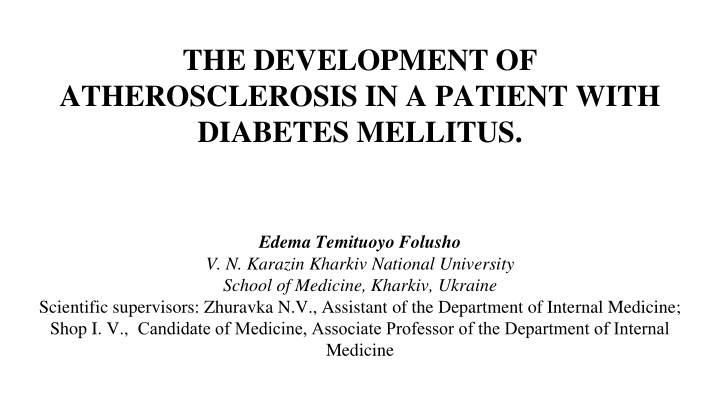



THE DEVELOPMENT OF ATHEROSCLEROSIS IN A PATIENT WITH DIABETES MELLITUS. Edema Temituoyo Folusho V. N. Karazin Kharkiv National University School of Medicine, Kharkiv, Ukraine Scientific supervisors: Zhuravka N.V., Assistant of the Department of Internal Medicine; Shop I. V., Сandidate of Medicine, Associate Professor of the Department of Internal Medicine
ATHEROSCLEROSIS The word atherosclerosis is of Greek origin and literally means focal accumulation of lipid (ie, athere [gruel]) and thickening of arterial intima (ie, sclerosis [hardening]). Atherosclerosis is a disease of large and medium-sized muscular arteries and is characterized by the following: ● Endothelial dysfunction ● Vascular inflammation ● Buildup of lipids, cholesterol, calcium, and cellular debris within the intima of the vessel wall
Atherosclerotic buildup results in the following: ● Plaque formation ● Vascular remodeling ● Acute and chronic luminal obstruction ● Abnormalities of blood flow ● Diminished oxygen supply to target organs By impairing or obstructing normal blood flow, atherosclerotic buildup causes myocardial ischemia.
TYPE 2 DIABETES MELLITUS Type 2 diabetes is characterized by a combination of peripheral insulin resistance and inadequate insulin secretion by pancreatic beta cells. Insulin resistance, which has been attributed to elevated levels of free fatty acids and proinflammatory cytokines in plasma, leads to decreased glucose transport into muscle cells, elevated hepatic glucose production, and increased breakdown of fat.
OUR PATIENT A 55 year old male who presented with complaints of attacks of dyspnea at night, which usually resolved in a sitting position, these attacks were sometimes accompanied by pain in the chest, transient rises in blood pressure, headaches. Anamnesis was significant for arterial hypertension (AH) (max 160/100 mm Hg, adapted to 140-130/80 mm Hg), he takes antihypertensive therapy (bisoprolol 10 mg per day, enalapril as required), chest pains since 2012 (he takes nitrates as needed). In May 2015, during ECG holter, a pathological number of ventricular extrasystoles and paroxysms of unstable ventricular tachycardia were detected.
In June 2015 - coronary angiography followed by stenting of PKA. In December 2018 due to the worsening of his condition - re-coronary angiography followed by stenting of the PNA. In January 2019 another deterioration. Diabetes mellitus since 1998, patient is taking metformin. Anamnesis vitae is unremarkable. Physical examination: BMI = 30 kg / m 2 . In lung auscultation weakened breath. RR – 16/min. Heart borders extended to the left on 2 cm of mid clavicular line, HR = 68 bpm, regular, no pulse deficiency, heart sounds are muted, accent of the II tone above the aorta. BP - 140/80 mm Hg. Liver: near the rib edge, no pain on palpation of the right hypochondriac region. Spleen: not palpated. Oedema of lower third of both shins. Pulsation on a. dorsalis pedis and a. tibialis posterior are reduced. The rest of physical examination is unremarkable.
● Complete blood count (17.01.19) shows erythrocytosis. ● Fasting blood glucose (17.01.19) - 17, 95 mmol/l. ● Glycosylated hemoglobin (19.01.19) - 7,2 %. ● Blood lipid spectrum (17.01.19) : within normal ● Echocardiography (17.01.19): atherosclerotic cardiosclerosis, aorta atherosclerosis, LV hypertrophy. ● Electrocardiography (ECG) (16.01.19): Left axis deviation, unifocal ventricular extrasystoles, HR = 68/min. Hypertrophy of the myocardium of the left ventricle. Subendocardial ischemia. ● X-ray (16.01.19): within age changes.
CLINICAL DIAGNOSIS Ischemic heart disease. Stable angina, II functional class. Arterial hypertension, II stage, 3 degree. CVD risk very high. Atherosclerosis of the coronary arteries. PКA stenting (22.05.15) PNA stenting (13.12.18) Ventricular extrasystolic arrhythmia with episodes of unstable ventricular tachycardia. Heart failure III FC, stage C. Diabetes mellitus II type, severe degree, decompensation. Diabetic polyneuropathy. Obesity 1 degree.
PATHOGENESIS OF DIABETES RELATED ATHEROSCLEROSIS Current suggestions show endothelial injury as the initial event in the genesis of atherosclerosis, followed by platelet adhesion and aggregation at the site of injury. - Hyperglycemia from insulin resistance with insulin deficiency increases oxidative stress and glycation. This release of free radicals increases lipid and lipoprotein peroxidation contributing to foam cell formation on arterial walls. - Insulin resistance plays a role by contributing to endothelial dysfunction through loss of nitric oxide. - Diabetes promotes platelet aggregation due to an increased inflammatory response that augments the generation of growth factors and also stimulates the proliferation and migration of smooth muscle cells both of which are associated with thrombosis. Diabetes is a prothrombotic state which can lead to an imbalance in atherosclerotic lesions and plaque instability.
OUR RECOMMENDED TREATMENT LIFESTYLE MODIFICATION Diet Control of compliance to medical recommendations PHARMACOLOGICAL TREATMENT Transfer of the patient to insulin Bisoprolol 10 mg per day Perindopril 4 mg per day Rosurvastatin 10 mg 1 time per day • Clopidogrel 75 mg 1 time per day • Torasemide 10 mg 1 time in 3 days, under the control of urea, creatinine, electrolytes
CONCLUSION It is believed that the patient’s earlier condition (Diabetes Mellitus) was the ● foundation for the rapid development of a more severe course of Cardiovascular Disease precipitated by atherosclerosis. ● Atherosclerotic changes develop not only faster, but also earlier in patients with diabetes, while reducing their life expectancy. In patients with diabetes compared to those without this disease, even though a normal cholesterol level of low-density lipoproteins in the blood is achieved, poor glycemic control in patients with Diabetes Mellitus is associated with the progression of atherosclerotic changes. So special attention should be directed to control level of glucose and continuous statin treatment as the benefits in foster prevention the In-stent restenosis under control of lipid profile and LFTs.
Recommend
More recommend